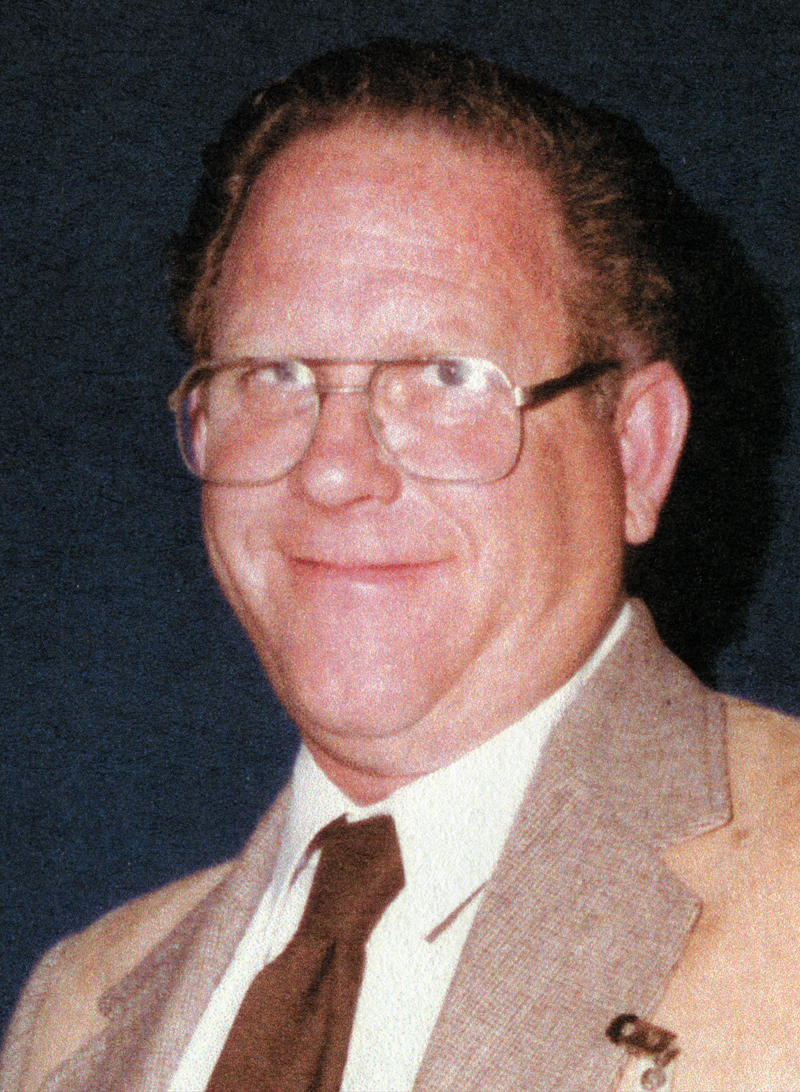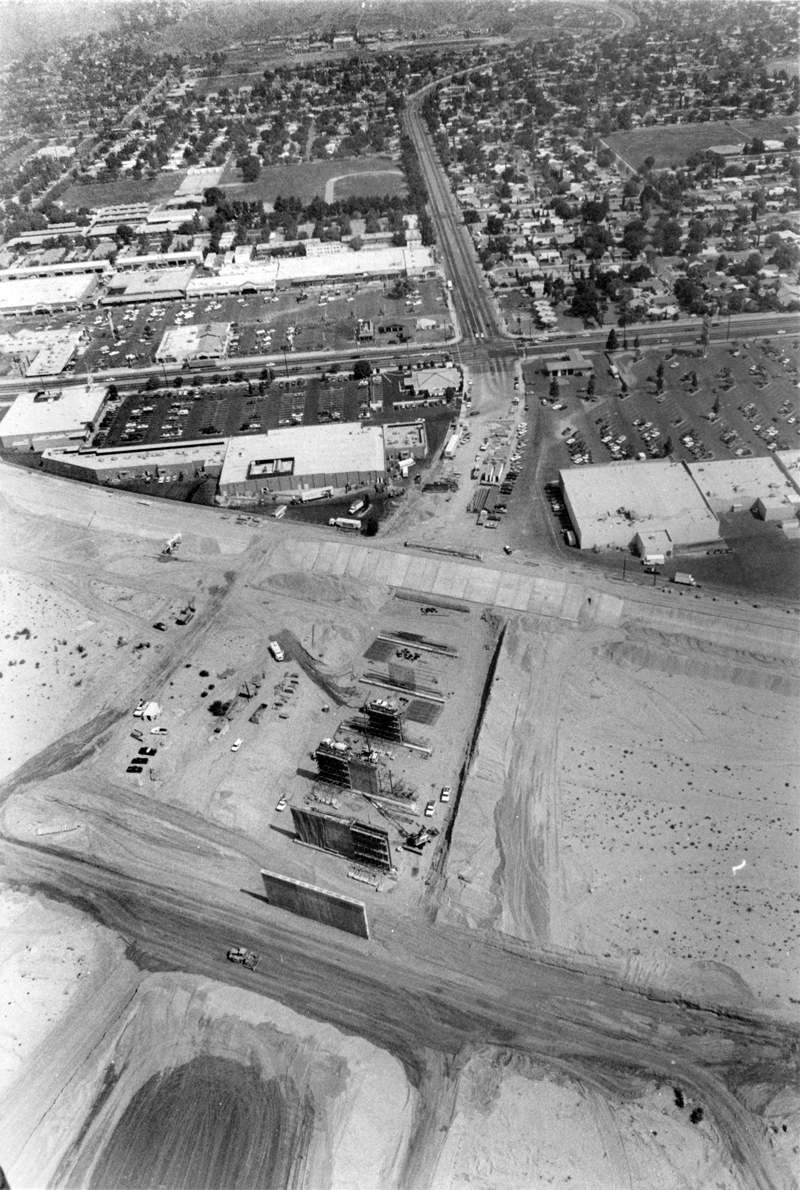Whites Canyon Bridge, shortly after construction began in 1988. Looking north. Santa Clara River in the foreground. The central east-west street is Soledad Canyon Road.
The Whites Canyon Bridge is an important component of the Santa Clarita Valley's traffic circulation network, relieving traffic congestion on Soledad Canyon Road by connecting "downtown" Canyon Country to the 14 Freeway by way of Via Princessa.
It was one of the last road projects completed by the county of Los Angeles inside the new city of Santa Clarita. Construction started in 1988, shortly after the city incorporated in December 1987. The county had collected funds for construction through bridge and thoroughfare district fees paid by housing and commercial developers.
As noted in the Times story below, the funding stream dried up when urban development slowed during the recession years of 1990-92. The bridge was built over the riverbed but it dead-ended in space, prompting locals to call it the "bridge to nowhere." It sat idle until after the 1994 Northridge earthquake when it was finally pushed through to Via Princessa.
'Bridge to Nowhere' Is Finally Opened
By Douglas Alger
Special to The Los Angeles Times | June 8, 1994
SANTA CLARITA — Canyon Country's "Bridge to Nowhere" finally goes somewhere.
On Tuesday, dozens of city and county officials gathered at a spot overlooking the Santa Clara River to officially open Whites Canyon Bridge — a project that had become a highly visible embarrassment.
For most of the last four years, the bridge over the river led from Whites Canyon Road on one side to nothing but an expanse of dirt on the other. The construction project, which started in 1988, came up short of completion funds in 1990.
"I got so many calls asking, 'When is that damn thing going to be done?,'" said Jo Anne Darcy, a field deputy for Supervisor Mike Antonovich and a Santa Clarita city councilwoman. "It just became a county joke for so many years."
The project soon took on its popular nickname.
"There were numerous newspaper articles over the years about the 'Bridge to Nowhere' and the frustration of local residents," said Donna Guyovich, spokeswoman for the county public works department. "That's why we were just as happy as the residents (to see it open), if not more so — to stop taking that teasing."
The project had been on Los Angeles County's highway plan since the 1960s and was considered critical as Santa Clarita's population ballooned in the 1980s. Its chief purpose was to provide direct access to Sierra Highway and the Antelope Valley Freeway, allowing traffic to avoid Canyon Country's busiest intersection: Soledad Canyon Road and Sierra Highway.
But numerous delays — led by a drop in new construction that dried up tax revenues — stalled construction, making the project an easy target for criticism by people who've seen it as nothing more than a multimillion-dollar dead-end for the past four years.
Construction finally resumed in September 1990, and was completed last week.
With the opening of the $27.4-million project, politicians wanted to look on the bright side.
"This morning, the bridge that was called the 'Bridge to Nowhere' will be called the 'Bridge to Everywhere,'" Antonovich said during the grand opening ceremony.
But Tuesday, the joke still had some life left.
As Antonovich was chauffeured over the route as its first passenger in a bright red 1958 Corvette provided by the Santa Clarita Valley Corvette Club, one watcher quipped that the car was new when construction began.
"At this rate, we're all going to be retired by the time they open another road," said Jack Curenton, leader of a Santa Clarita citizens group that has clamored for city road improvements.
Witticisms aside, many residents are simply happy to be able to use the road.
"Behind it all and over it all, I hoped they would finish what they started planning 25 years ago," said Jack Ancona, a local transportation activist. "We've been waiting for this for so long; everybody on this side of the valley is going to want to use it."
The construction delay had some benefits.
When Metrolink suddenly found itself needing to expand its Santa Clarita route after the Northridge earthquake, improvements to the Whites Canyon Road crossing could be made without having to work around a busy road.
And Mayor George Pederson, although reluctant to criticize the project, expressed the hope that the city had learned an important lesson for future construction projects.
"We need to have the money, when we start them, to be able to finish them."
 About the photographer: Photojournalist Gary Thornhill chronicled the history of the Santa Clarita Valley as it unfolded in the 1970s, '80s and '90s. From car races in Saugus to fatal car wrecks in Valencia; from topless beauty contests in Canyon Country to fires and floods in the various canyons; from city formation in 1987 to the Northridge earthquake in 1994 — Thornhill's photographs were published in The Los Angeles Times, The Newhall Signal, The Santa Clarita Valley Citizen newspaper, California Highway Patrolman magazine and elsewhere. He penned the occasional breaking news story for Signal and Citizen editors Scott and Ruth Newhall under the pseudonym of Victor Valencia, and he was the Santa Clarita Valley Sheriff Station's very first volunteer — and only the second in the entire LASD. Thornhill retained the rights to the images he created; in 2012, he donated his SCV photographs to two nonprofit organizations — SCVTV and the Santa Clarita Valley Historical Society — so that his work might continue to educate and inform the public.
About the photographer: Photojournalist Gary Thornhill chronicled the history of the Santa Clarita Valley as it unfolded in the 1970s, '80s and '90s. From car races in Saugus to fatal car wrecks in Valencia; from topless beauty contests in Canyon Country to fires and floods in the various canyons; from city formation in 1987 to the Northridge earthquake in 1994 — Thornhill's photographs were published in The Los Angeles Times, The Newhall Signal, The Santa Clarita Valley Citizen newspaper, California Highway Patrolman magazine and elsewhere. He penned the occasional breaking news story for Signal and Citizen editors Scott and Ruth Newhall under the pseudonym of Victor Valencia, and he was the Santa Clarita Valley Sheriff Station's very first volunteer — and only the second in the entire LASD. Thornhill retained the rights to the images he created; in 2012, he donated his SCV photographs to two nonprofit organizations — SCVTV and the Santa Clarita Valley Historical Society — so that his work might continue to educate and inform the public.













